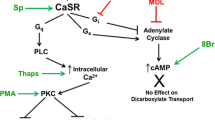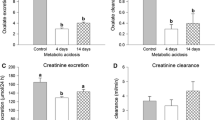Abstract
The oxalate transport system along with protein phosphorylation appears to be deranged in stone formers. This study was undertaken to characterize in LLC-PK1 cells in culture the effect of altering specific intracellular second messenger systems on oxalate uptake. Cellular uptake experiments were performed at 37°C in buffer [265 mM mannitol, 5 mM NaOH, 5 mM KOH, 10 mM Ca-EGTA, 25 mM HEPES/TRIS, pH=7.4 or in Hank's balanced salt solution (HBSS)] containing 200 μM labeled oxalate (1-14C, 0.3 μCi). Cells were preincubated with DAG (final concentration of 100 μM), phorbol myristate acetate (10 μM), forskolin (50 μM), 8-bromo-cyclic AMP (50 μM), trifluoroperazine (20 μM) and low molecular weight heparin (1 mg/ml) for 10 min in the presence and absence of the anion transport inhibitor DIDS (100 μM) and the effect(s) on oxalate uptake at 10, 25 and 45 min incubation were determined. Chemicals (DAG, forskolin, TPA and 8-bromo-cAMP) which stimulate protein kinase A or C activity resulted in an increased uptake of oxalate while inhibitors of these systems (trifluoroperazine and low molecular weight heparin) resulted in decreased oxalate uptake. The results dernonstrate that oxalate uptake in renal tubular cells is modulated by protein kinase C and A dependent mechanisms.
Similar content being viewed by others
References
Baggio B, Gambaro G, Marchini F, Cicerello E, Tenconi R, Clementi M, Borsatti A (1986) An inheritable anomaly of red-cell oxalate transport in “primary” calcium nephrolithiasis correctable with diuretics. N Engl J Med 314:599
Baggio B, Gambaro G, Cicerello E, Mastrosimone S, Marzaro G, Borsatti A, Pagano F (1987) Urinary excretion of glycosaminoglycans in urological disease. Clin Biochem 20:449
Baggio B, Marzaro G, Gambaro G, Marchini F, Williams HE, Borsatti A (1990) Glycosaminoglycan contents, oxalate self exchange and protein phosphorylation in erythrocytes of patients with “idiopathic” calcium oxalate nephrolithiasis. Clin Sci 79:113
Baggio B, Gambaro G, Marchini F, Marzaro G, Williams HE, Borsatti A (1991) Correction of erythrocyte abnormalities in idiopathic calcium oxalate nephrolithiasis and reduction of urinary oxalate by oral glycosaminoglycans. Lancet 338:403
Baggio B, Bordin L, Gambaro G, Piccoli A, Marzaro G, Clari G (1993) Evidence of a link between erythrocyte band 3 phosphorylation and anion transport in patients with idiopathic calcium oxalate nephrolithiasis. Miner Electrolyte Metab 19:17
Borsatti A (1991) Calcium oxalate nephrolithiasis: defective oxalate transport. Kidney Int 39:1283
Cantaro S, Marchini F, Calò L, Gambaro G, Piccoli A, Williams HE, Baggio B, Borsatti A (1989) Oxalate exchange in red blood cells of calcium oxalate stone formers: a pharmacological study. In: Walker VR, Sutton RAL, Cameron ECB, Pak CYC, Robertson WG (eds) Urolithiasis. Plenum Press, New York, p 443
Cantaro S, Calò L, Piccoli A, Marchini F, Gambaro G, Favaro S, Williams HE, Borsatti A (1992) Anomalous inositol trisphosphate production in idiopathic calcium oxalate nephrolithiasis. Nephron 61:241
Cautiello HF, Scott JA, Rabito CA (1986) Polarized distribution of the Na+/H+ exchange system in a renal cell line (LLC-PK1) with characteristics of proximal tubular cells. J Biol Chem 261:3252
Chaillet JR, Ansler K, Boron WF (1986) Optical measurements of intracellular pH in single LLC-PK1 cells: demonstration of Cl/HCO3 exchange. Proc Natl Acad Sci USA 83:522
Chang EB, Wang NS, Rao MC (1985) Phorbol ester stimulation of active anion secretion in intestine. Am J Physiol 249:C356
Dunk CR, Brown CDA, Tunberg LA (1989) Stimulation of Cl/HCO3 exchanger in rat duodenal brush border membrane vesicles by cAMP. Pflugers Arch 414:701
Fondacaro JD, Shlatz Henderson L (1985) Evidence for protein kinase C as a regulator of intestinal electrolyte transport. Am J Physiol 249:G422
Hatch M, Freel RW, Vaziri ND (1994) Mechanisms of oxalate absorption and secretion across the rabbit distal tubule. Pflugers Arch 426:101
Hays S, Kokko JP, Jacobson HR (1986) Hormonal regulation of proton secretion in rabbit medullary collecting duct. J Clin Invest 78:1279
Jay D, Cantley L (1986) Structural aspects of the red cells anion exchange protein. Annu Rev Biochem 55:511
Karniski LP, Aronson PS (1987) Anion exchange pathways for Cl- transport in rabbit renal microvillus membranes. Am J Physiol 253:F513
Knickelbein RG, Aronson PS, Dobbins JW (1986) Oxalate transport by anion exchange across rabbit ileal brush border. J Clin Invest 77:170
Kok DJ, Papapoulos SE, Blomen LJML, Bijvoet OLM (1988) Modulation of calcium oxalate monohydrate crystallization kinetics in vitro. Kidney Int 34:346
Kuo S, Aronson PS (1988) Oxalate transport via the sulphate/HCO3 exchanger in rabbit renal basolateral membrane vesicles. J Biol Chem 263:9710
Laxmanan S, Selvam R, Mahle CJ, Menon M (1986) Binding of oxalate to mitochondrial inner membranes of rat and human kidney. J Urol 15:862
Michelacci YM, Glashan RQ, Schor N (1989) Urinary excretion of glycosaminoglycans in normal and stone forming subjects. Kidney Int 36:1022
Mullin JM, Weibel J, Diamond L, Kelinzeller A (1980) Sugar transport in the LLC-PK1 renal epithelial cell line: similarity to mammalian kidney and the influence of cell density. J Cell Physiol 104:375
Rabito CA (1986) Phosphate uptake by a kidney cell line (LLC-PK1). Am J Physiol 245:F22
Rasmussen H, Barret PQ (1984) Calcium messenger system: an integrated view. Physiol Rev 64:938
Robertson WG, Peacock M (1980) The cause of idiopathic calcium stone disease: hypercalciuria or hyperoxaluria? Nephron 26:105
Seamon KB, Daly JW (1982) Forskolin: a unique diterpene activator of cyclic AMP-generating systems. J Cyclic Nucleotide Res 7:201
Senekjian HD, Weinman EJ (1982) Oxalate transport by proximal tubule of the rabbit kidney. Am J Physiol 243:F271
Sepulveda FV, Pearson JD (1982) Characterization of neutral amino acid uptake by cultured epithelial cells from pig kidney. J Cell Physiol 112:182
Ullrich KJ, Rumrich G (1988) Contraluminal transport systems in the proximal renal tubule involved in secretion of organic anions. Am J Physiol 254:F453
Wandzilak TR, Calò L, D'Andre S, Borsatti A, Williams HE (1992) Oxalate transport in cultured renal epithelial cells. Urol Res 20:341
Wise BC, Glass DB, Chou CJ, Raynor RL, Katoh N, Schatzman RC, Turner RS, Kibler RF, Kuo JF (1982) Phospholipid-sensitive Ca++ dependent protein kinase from heart. J Biol Chem 257:8489
Author information
Authors and Affiliations
Rights and permissions
About this article
Cite this article
Calò, L., Wandzilak, T.R., Davis, P.A. et al. Effect of second messenger systems on oxalate uptake in renal epithelial cells. Urol Res 23, 89–94 (1995). https://doi.org/10.1007/BF00307938
Received:
Accepted:
Issue Date:
DOI: https://doi.org/10.1007/BF00307938




